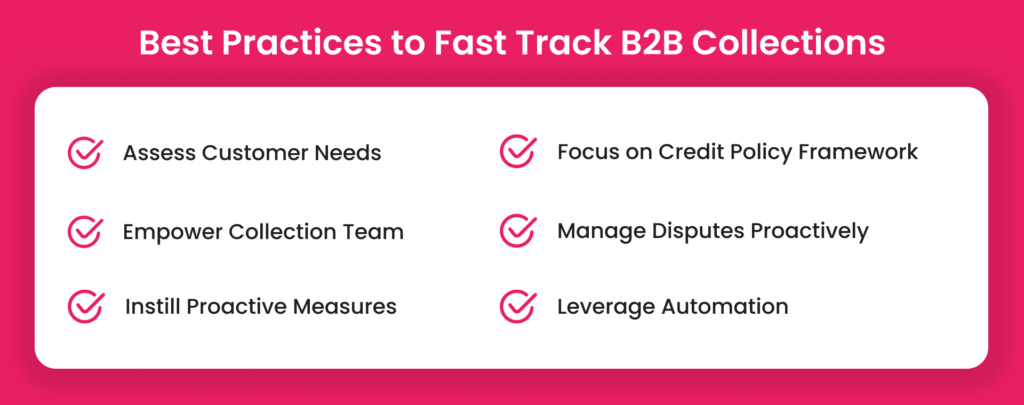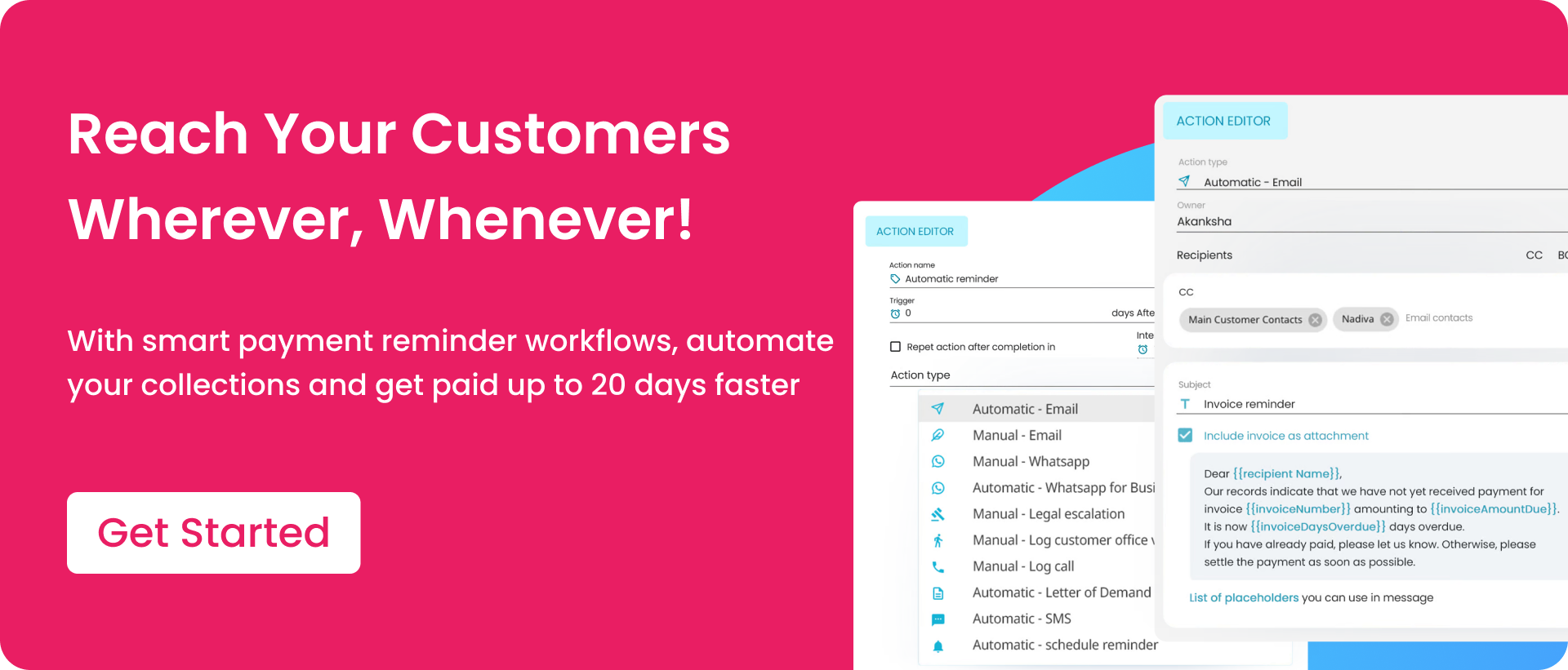In an ideal world, businesses would manage B2B collections perfectly, and every client would pay their bills in full and on time. But in reality, that doesn’t always happen. Businesses need to set up effective processes to handle clients who struggle to pay.
Using best practices in B2B collections helps reduce problems and creates more transparency with clients. Instead of waiting for payment issues to arise, these practices take a proactive approach and consider each client’s unique situation.
In this blog, we’ll discuss ways to improve the effectiveness and efficiency of your B2B collections process.
What is B2B Collections?
B2B collections are about getting overdue payments from one business to another. It helps make sure companies pay what they owe on time, keeping both sides financially stable and settling any unpaid invoices quickly.
Step-by-Step Process of B2B Collections
B2B collections typically follow a series of steps:
Step 1: Communication
The process starts with a friendly reminder or invoice sent to the business that owes money. This gentle reminder helps in cases where the debtor either forgot to pay or thought they already had. It gives them a chance to clear the outstanding balance.
Step 2: Follow-up
If the initial communication doesn’t result in payment, the creditor may follow up with dunning letters and make collection calls. This helps remind the debtor of the unpaid amount and encourages them to pay quickly.
Step 3: Demand Letter
If reminders don’t work, a stronger demand letter, often written by a B2B collections lawyer, may be used to push for payment.
Step 4: Negotiation
When the debtor can’t pay the full amount, they might negotiate. This could mean setting up a payment plan, agreeing to a lower amount, or finding other solutions that work for both sides.
Step 5: Investigation
If there is no response or the debtor claims they cannot pay, creditors may investigate to check if the debtor’s situation is genuine.
Step 6: Collection agencies
Sometimes, creditors hire a collection agency to help recover unpaid debts. These agencies are experts in collecting debt and use effective methods to get the money.
Step 7: Commercial Litigation
As a last option, taking legal action might be needed, which involves going to court. This choice depends on how strong the case is and the amount of debt owed. However, it’s important to consider legal costs, as they could be higher than the amount recovered. If debtors don’t respond, a default judgment may be given, but this doesn’t guarantee payment, especially if the debtor files for bankruptcy later.
Mistakes to Avoid in B2B Collections
When collecting debts in B2B transactions, avoiding mistakes is crucial for healthy cash flow and good business relationships. Here are common errors and tips to prevent them:

Lack of Clear Communication
Neglecting clear communication is a big mistake in debt collection. If you don’t keep in touch with customers via transparent communication channels, it can lead to confusion and delays in payments.
To avoid this, keep communication open from the beginning. Clearly explain your payment terms and expectations, and address any issues or concerns as soon as they arise. This helps ensure a smoother process and reduces the risk of payment delays.
Failure to Recognize Early Warning Signs
A common mistake is ignoring early signs of payment problems. It’s crucial to stay vigilant and identify signs that a client might be experiencing financial difficulties. Look out for late payments, requests for longer terms, or changes in a client’s business.
Spotting these signs early helps you address issues before they impact your cash flow.
Insufficient Record-Keeping
In B2B collections, keeping detailed records is essential. Without accurate documentation of invoices, payment agreements, and communications, it’s hard to track unpaid bills and resolve disputes.
To avoid this, create a clear audit trail of all interactions with clients, including emails, phone calls, and written agreements. This helps keep things organized and provides important evidence if you need to take legal action.
Inflexible Payment Plans
Having overly rigid payment plans can create obstacles in the debt collection process. Although it’s crucial to set clear payment terms, being overly inflexible can distance clients and make it challenging for them to meet their obligations.
Provide flexible payment alternatives, such as partial payment plans or extended payment terms, especially for clients experiencing temporary financial challenges. This strategy supports maintaining a positive relationship while still guaranteeing timely payments.
Neglecting Follow-Up on Overdue Payments
To successfully collect overdue debts, you need to follow up diligently. Many businesses make the mistake of assuming clients will pay on time without reminders, but that’s often not true.
Set up a clear process for following up on overdue payments. This means sending friendly reminders and using escalation steps if needed. By being proactive, you’ll greatly improve your chances of getting the money you’re owed.
Dependance on Manual Processes
Relying only on manual methods for debt collection can be very time-consuming and boring. When your team spends too many hours on repetitive tasks, it can lower job satisfaction, increase turnover, and lead to more mistakes.
On the other hand, using automation in your collection process lets your team focus on the most difficult clients. This way, your company can improve late payment collections, while automation takes care of the routine tasks.
Best Practices to Fast Track B2B Collections

Assess Customer Needs
- Conduct detailed surveys to understand what customers need for successful transactions.
- Offer various payment methods like online, credit card, and wire transfers to make it easier for customers to pay invoices on time.
- Create a clear, easy-to-follow guide to help customers navigate the transaction process and avoid confusion.
Empower Collection Team
- Provide training for analysts on how to communicate and negotiate effectively.
- Keep the team and stakeholders updated on changes in credit policies and market trends so they can adjust their strategies.
- Hold individual account review sessions to give personalized advice and improve team performance.
Instill Proactive Measures
- Set up clear communication steps to start collecting overdue payments quickly, so you can respond fast.
- Create specific rules for handling short or extra payments in cash applications to keep your accounts accurate.
- Use specialized ERP tools for better automation and reporting in collections, making the process more efficient.
Focus on Credit Scoring and Policy Framework
- Use detailed credit reports and data analytics to evaluate customer creditworthiness, helping you allocate resources wisely.
- Hold regular meetings between leadership and collections teams to plan account management and spot risks and opportunities.
- Keep open communication among stakeholders to set suitable credit limits, minimizing the chances of overextension and defaults.
Manage Disputes Proactively
- Set up a clear system to spot and fix disputes early to avoid cash flow issues and preserve business relationships.
- Create a central place to store all claim documents for quick access and efficient resolution with accurate, up-to-date information.
- Focus on quickly researching and resolving disputes by having dedicated teams handle complex or high-value issues promptly.
Leverage Automation
- Use modern billing software to automate creating and sending invoices.
- Add self-service payment portals with secure payment options for quicker invoice payments, cutting down on admin tasks.
- Make sure payment portals work with various global ERP systems to enable smooth, secure transactions across different platforms and regions.
Streamline Your Collections Process
Automating your B2B collections saves time and boosts efficiency. Here’s how to streamline your process:
- Utilize a solution that can generate and send invoices automatically. This eliminates the need for manual entry and ensures timely invoice delivery.
- Send automated reminders to customers for upcoming or overdue payments. This proactive approach helps reduce late payments and improves overall cash flow.
- Provide customers with the convenience of online payment options, such as PayPal or Razorpay. It simplifies the payment process for them and increases the likelihood of prompt payments.
- Consider employing electronic funds transfer or ACH payments for recurring invoices. This not only streamlines the collection process but also eliminates the manual effort involved in check processing.
- Create a secure online customer portal where they can access account information, view invoices, and make payments. This self-service option is a time-saving solution for both your business and your customers.
- Invest in collections software designed to simplify collection workflow. These tools can create tasks, send automated reminders, track payment history, and generate reports, assisting you in managing and prioritizing collections efforts.

Peakflo’s Collections Task Management and Automated Reminder solution streamlines and customizes your collections process, providing significant time savings for your team. It automatically prioritizes accounts and generates personalized communications tailored to customers. This strategic approach enables your team to concentrate their efforts on high-risk accounts, optimizing efficiency and enhancing overall collection outcomes.















































